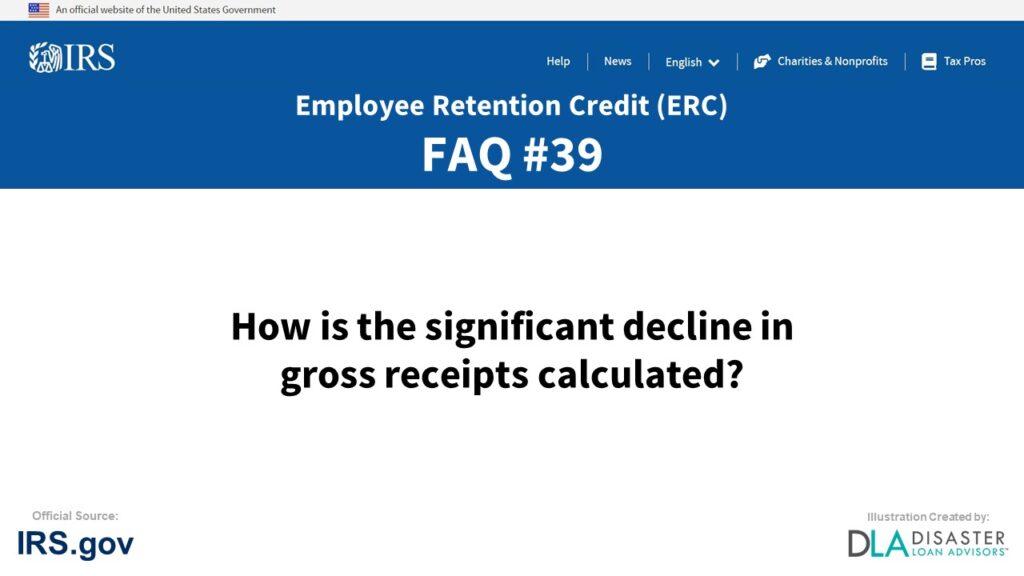
Frequently asked question #39 “How is the significant decline in gross receipts calculated?” under the Determining When an Employer is Considered to have a Significant Decline in Gross Receipts section of FAQs: Employee Retention Credit under the CARES Act, provided by the IRS.gov to help business owners understand the ERC program. Information is below for the question #39 How is the significant decline in gross receipts calculated?
ERC Credit Frequently Asked Question #39:
COVID-19-Related Employee Retention Credits:
Determining When an Employer is Considered to have a Significant Decline in Gross Receipts and Maximum Amount of an Eligible Employer’s Employee Retention Credit FAQs
39. How is the significant decline in gross receipts calculated?
A significant decline in gross receipts is calculated by determining the first calendar quarter in 2020 (if any) in which an employer’s gross receipts are less than 50 percent of its gross receipts for the same calendar quarter in 2019.
If the gross receipts decline to that extent, the employer also must later determine if there is a later calendar quarter in 2020 in which the employer’s 2020 quarterly gross receipts are greater than 80 percent of its gross receipts for the same calendar quarter in 2019.
If so, the significant decline in gross receipts ends with the first calendar quarter that follows the first calendar quarter in which the employer’s 2020 quarterly gross receipts are greater than 80 percent of its gross receipts for the same calendar quarter in 2019, or with the first calendar quarter of 2021.
Example: Employer I’s gross receipts were $100,000, $190,000, and $230,000 in the first, second, and third calendar quarters of 2020, respectively. Its gross receipts were $210,000, $230,000, and $250,000 in the first, second, and third calendar quarters of 2019, respectively.
Thus, Employer I’s 2020 first, second, and third quarter gross receipts were approximately 48 percent, 83 percent, and 92 percent of its 2019 first, second, and third quarter gross receipts, respectively.
Accordingly, Employer I had a significant decline in gross receipts commencing on the first day of the first calendar quarter of 2020 (the calendar quarter in which gross receipts were less than 50 percent of the same quarter in 2019) and ending on the first day of the third calendar quarter of 2020 (the quarter following the quarter for which the gross receipts were more than 80 percent of the same quarter in 2019).
Thus, Employer I is entitled to a retention credit with respect to the first and second calendar quarters.
For more Internal Revenue Service (IRS) Department of the Treasury Employee Retention Credit (ERC) Determining When an Employer is Considered to have a Significant Decline in Gross Receipts FAQs, visit the official IRS.gov tax website.
Conclusion and Summary on ERC Credit FAQ #39. How is the significant decline in gross receipts calculated?
The “How is the significant decline in gross receipts calculated?” is Frequently Asked Question #39 of many commonly asked questions small business owners are wondering about how to file the Employee Retention Tax Credit (ERTC). The IRS ERC Tax Credit program is a confusing and complex process to determine the correct ERC calculations your business qualifies for. Answers to “How is the significant decline in gross receipts calculated?” and filling out form 941-X may change slightly from frequently updated rules and regulations from the IRS. Leave a comment below if you have further questions on ERC Credit FAQ #39.
Help Completing / Filing / Claiming the Employee Retention Credit (ERC)
Receive Up to a $26,000 ERC Credit from the IRS Per Employee
Disaster Loan Advisors can assist your business with the complex and confusing Employee Retention Credit (ERC), Form 941-X, and the Employee Retention Tax Credit (ERTC) program.
Depending on eligibility, business owners and companies can receive up to $26,000 per employee based on the number of W2 employees you had on the payroll in 2020 and 2021.
The ERC / ERTC Tax Credit Program is a valuable IRS tax credit you can claim. This is money you have already paid to the IRS in payroll taxes for your W2 employees.
We DO NOT charge a percentage (%) of your ERC Refund like some companies are charging. Some ERC firms out there are charging upwards of 15% to 35% of your ERC refund!
Our professional ERC fee and pricing structure is very reasonable in comparison.
If you are looking for an ERC Company that believes in providing professional ERC Services and value, in exchange for a fair, reasonable, and ethical fee for the amount of work required, Disaster Loan Advisors is a good fit for you.
Schedule Your Free Employee Retention Credit Consultation to see what amount of employee retention tax credit your company qualifies for.
Cover Image Credit: Irs.gov / ERC FAQ / Disaster Loan Advisors.
